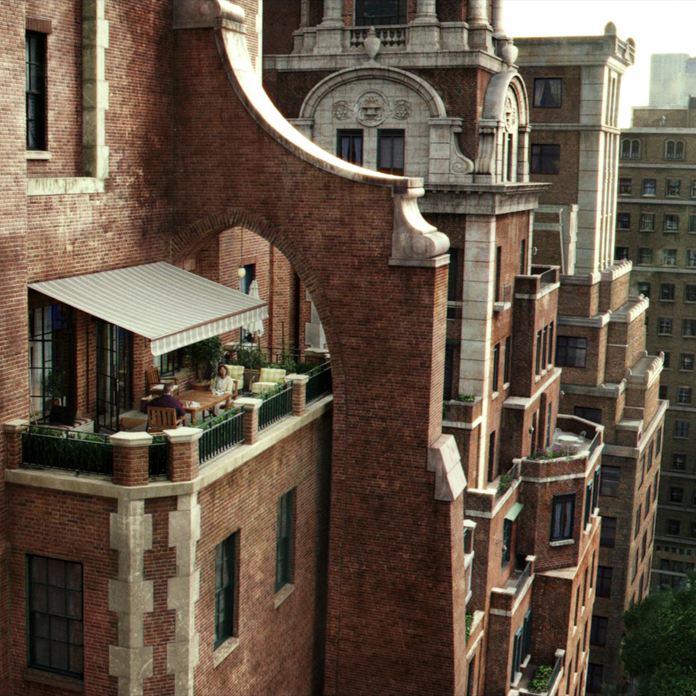and Peter Pennoyer
They weren’t schoolboy crushes, but pretty close. Walking to class at Buckley in the East 70s, writes the interior designer and architecture scholar David Netto in Rosario Candela & the New York Apartment, 1927–1937, certain buildings on those white-glove blocks “found me only looking up.”
Barely out of Yale when he joined The New York Times as an architecture critic, Paul Goldberger was struck by how many of the luxury apartment buildings he admired for their particular brand of stylish New York opulence were by an architect “I’d never heard of.”
The architect Peter Pennoyer was hooked as a teenager by “the glimmering, glamorous abodes of certain well-heeled friends.” (Though this Whit Stillman–esque, nose-pressed-against-the-glass self-portrayal omits that he inherited his middle initial, M, from his great-great-grandfather J. P. Morgan.)

All grown up and then some (Goldberger is the one with the Pulitzer Prize), they’ve banded together under Netto for an in-depth look at the architect who gave old-money New York a Jazz Age infusion, and Americans a skyline for their dreams.
Because Candela’s name is now real-estate shorthand for the most exclusive bastions of inherited privilege and new-money billions, it can be hard to envision the prolonged obscurity that engulfed it as the city entered economic free fall with the Crash of 1929. Architecture was more about people jumping out of windows as the stock market tanked than the finer points of the iconic Manhattan penthouses Candela devised in response to a city zoning mandate for staggered stepbacks once a building hit 12 floors.
Goldberger’s 1979 The City Observed issued an initial nod of recognition. By 2018, when the Museum of the City of New York mounted “Elegance in the Sky: The Architecture of Rosario Candela,” designed by Pennoyer, Candela’s limestone cloudscrapers were no longer the hapless white elephants that had come lumbering out of the Great Depression. They were history in turnaround. And Jacqueline Onassis had lived in one.

But time’s quirks seldom act alone. Although Candela eschewed headlines and the limelight, Rosario Candela makes elegant inroads where details of his life and career have been sparse. Game-changing and gorgeous, it mixes sumptuous color photographs with painstakingly researched period images, archival records, and original floor plans, and deftly decodes them. It elucidates an architect who reconceived urbane living, innovated the hallmarks of American aspiration, and provided the infrastructure from which they were staged. (In the 1936 movie Follow the Fleet, Ginger Rogers and Fred Astaire dance on a set inspired by the facing roofscapes of Candela’s 770 and 778 Park Avenue.)
Winnowing Candela’s 75 buildings to a select 18 “that count,” the book designates One Sutton Place South, once complete with a “commuter yacht” marina, the southernmost point, and its northernmost, at 94th Street, as 1220 Park. All strove for the ideals of “perfection and serenity” evidenced in the Candela design philosophy. The aim was to nest the ruffled feathers of an upper class worried about outside interlopers insinuating a changing world, and to soften the newcomers’ rougher edges once inside. Prejudice prevailed: few Jews, and no Blacks, passed muster.
Yet the man at the drafting table was the opposite of his clientele in all but a predilection for privacy. A Sicilian-born plasterer’s son, Candela graduated from Columbia’s Wasp-y architecture school, his Italian accent—and lack of social connections—intact, his hair a permanent crew cut, his family life remote, in Westchester County, his architectural practice shrouded in the myth that he drew behind a velvet rope.

Success arrived with two fellow Sicilians, the developers Anthony Campagna and Joseph Paterno, who needed the right architectural sensibility for an Upper East Side tearing down its ornate Gilded Age châteaux to make way for sleeker, amenity-rich apartment buildings capable of housing “mansions in the sky.” Though no two Candela buildings were alike, their façades and decorative details were unified by the architect’s introduction of an Italianate design vocabulary.
Candela’s genius included a cryptographer’s ability to puzzle out the intricacies of fitting multiple town-house-size layouts within the limits of a Manhattan building plot. He maximized scale and light within J. E. Carpenter’s newly prevalent scheme of public, private, and staff spaces separated by a centralized entrance foyer. His duplexes’ signature staircases invited the downsweep of filmy cocktail dresses and formal ball gowns. (Pennoyer has a “staircase à la Candela” in his design repertoire; Robert A. M. Stern, a raft of Candela quotations.) Candela wrote two books on cryptography and worked as a cryptographer for American intelligence during the Second World War.
Rosario Candela sticks to architecture over biography, and discretion over disclosure. Its foreword, by Aerin Lauder, models the mannerly avoidance of specificity that someone “lucky enough to … have had the great pleasure of calling his buildings home” can manipulate adroitly.

To do otherwise, the book implies, would be untoward, and against the grain of an architecture that stressed gracious living behind closed doors. When it does name names alongside the building addresses that have become a nomenclature themselves, it tends toward the protective past tense: Brooke Astor’s office, dubbed her “Money Room,” at 778 Park Avenue; Jacqueline Onassis and her “bohemian”(though that’s relative) Candela apartment, at 1040 Fifth; assorted others that change hands and decorating tastes according to celebrated marriages, hostessing powers, and, above all, divorces. The book’s acknowledgments appreciate that many of its sources wish to remain anonymous.
In tone it shares little with journalist Michael Gross’s gossipalooza 740 Park: The Story of the World’s Richest Apartment Building, which made scandalizing waves in 2005.
But it’s also striking the extent to which the newly super-rich deemed disreputable by Gross at the time—Stephen Schwarzman was a standout—now rate as giants of philanthropy and pillars of society, as comfortably ensconced in the pages of Rosario Candela as Candela’s buildings fit themselves onto pedigreed properties where all roads led to a rarefied existence. With the holidays approaching, the book is a natural for gift-giving up and down Candela’s avenues.
Celia McGee, a New York–based arts-and-culture reporter, writes regularly about books for AIR MAIL,The New York Times, and other publications


